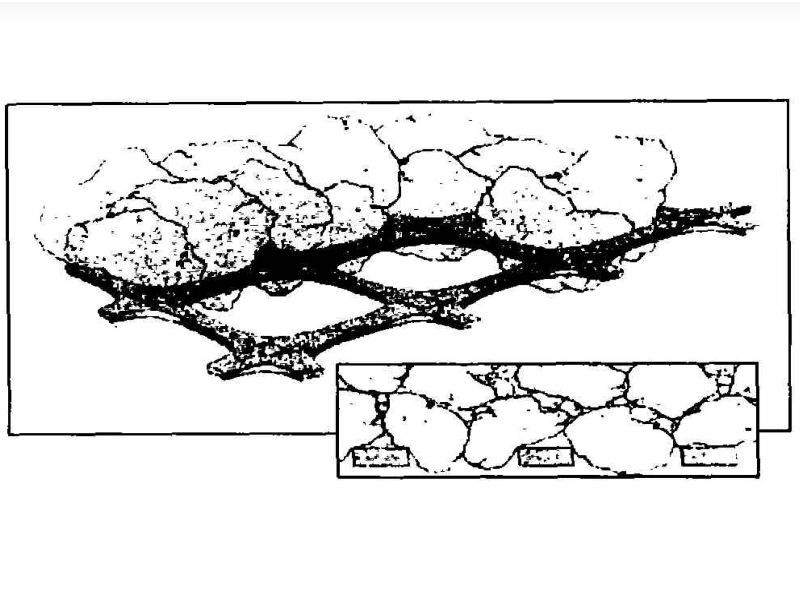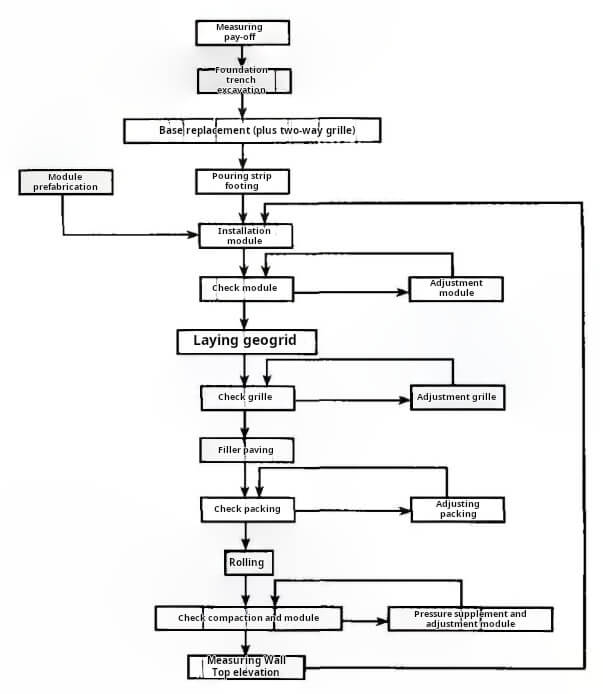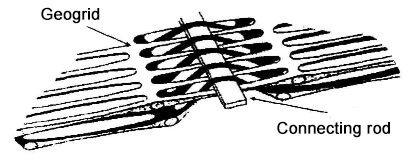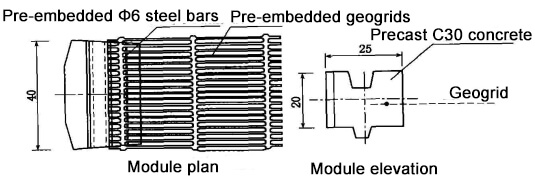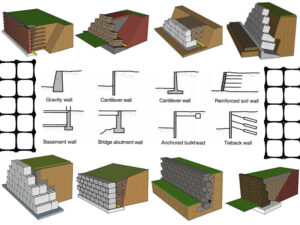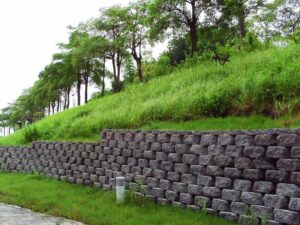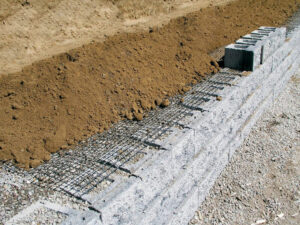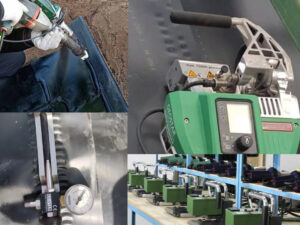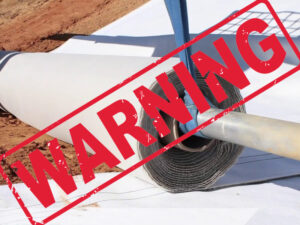Geogrid retaining walls are one of the most widely used technologies in civil engineering today. The main advantages of geogrid retaining wall systems are their cost-effectiveness and ease of construction. In this article, QIVOC will provide a detailed introduction to the definition of geogrid retaining walls, the reasons for incorporating geo grids into retaining walls, the installation process, and the building of geogrid retaining walls.
What is geogrid retaining wall?
A geogrid retaining wall involves incorporating geogrids into the soil behind a retaining wall for reinforcement. A geogrid retaining wall comprises three main components: the backfill, the reinforcing geogrid strips within the backfill, and the wall face panels. The friction between the backfill and the geogrids reduces the lateral earth pressure, stabilizing the soil mass.
Geogrid retaining walls are flexible structures that can adapt to foundation deformations, making them suitable for high embankments and fill subgrades. However, it is essential to consider the drainage stability of the backfill behind the panels and the impact of foundation deformations. Therefore, careful calculation and analysis are required for their design and selection.
Do I need geogrid for the retaining wall?
The building of retaining walls requires geogrids mesh.
Retaining walls are common civil engineering structures used to prevent soil slippage and erosion, protecting land and buildings. Geogrids are used in the construction of retaining walls primarily due to the following advantages.
1. Geogrids can increase the stability of retaining walls.
Retaining walls bear significant pressure from the soil, and geogrids can distribute this pressure evenly across the entire structure, thereby enhancing the overall stability of the wall. Additionally, geogrids prevent soil slippage and erosion, maintaining the integrity of the retaining wall.
2. Geogrids can improve the seismic performance of retaining walls.
Earthquakes pose a significant threat to the stability of retaining walls. Geogrids, with their flexibility and extensibility, can effectively absorb and dissipate the impact forces caused by earthquakes, reducing vibrations and improving the wall’s seismic performance.
3. Geogrids can enhance the permeability of retaining walls.
Permeability is a crucial factor in the construction of retaining walls. Poor permeability can lead to water pressure buildup behind the wall, increasing the pressure on the structure and compromising its stability. Geogrids have good permeability, effectively draining water and reducing water pressure on the retaining wall.
4. Geogrids can increase the durability of retaining walls.
Retaining walls need to withstand soil pressure and environmental influences over long periods, making durability an important consideration. Geogrids are resistant to corrosion and aging, effectively extending the service life of retaining walls.
5. Geogrids can reduce construction costs and time for retaining walls.
Incorporating geogrids with shotcrete in retaining wall construction can save 30%-50% of the project budget and cut the construction time by more than half. This method also extends the lifespan of the retaining wall, up to 100 years.
The construction process is quick and convenient, with a short cycle and low cost. The installation, overlap, and positioning of geogrids are easy and smooth, avoiding overlapping and intersection issues, which effectively shortens the project duration and saves 30%-50% of the construction cost. These advantages collectively demonstrate that using geogrids in retaining wall systems is an excellent choice.
When to use geogrid in retaining walls?
Using geo grids in retaining walls is a popular choice in civil engineering. However, their advantages are maximized in the following situations:
1. Increasing Wall Height
When retaining walls exceed a certain height (typically around 3 meters or 10 feet for traditional gravity walls), geogrids can reinforce the soil. This helps reduce the lateral earth pressure on the wall, allowing for taller walls without excessive mass or structural complexity.
2. Poor Soil Conditions
In areas with weak or poorly graded soils (such as loose sand, silt, or clay), reinforcing the soil with geogrids enhances its overall shear strength, bearing capacity, and reduces settlement issues. Geogrids can effectively distribute loads and reduce the risk of wall collapse by reinforcing the backfill material.
3. Inclined Backfill or Surfaces
When constructing retaining walls on sloped surfaces or with inclined backfill, geogrids provide necessary reinforcement to stabilize the soil and prevent slippage along the slope.
4. Heavy Loads
When retaining walls need to support heavy loads (such as roads, buildings, or other structures), geogrids help distribute the load more evenly and improve wall stability. This is particularly important for infrastructure projects requiring high safety standards.
5. Seismic Zones
In earthquake-prone areas, geogrids enhance the flexibility and energy absorption capacity of retaining walls. This makes the structure more resistant to dynamic forces during seismic events, reducing the risk of catastrophic failure.
6. Steep Excavations
For projects involving steep excavations or cut slopes, geogrids provide essential reinforcement to hold the soil and prevent slope failure. This is crucial in urban areas or places with limited space where traditional retaining methods are impractical.
7. Cost-Effective Solution
Compared to traditional retaining wall designs (such as concrete gravity walls or cantilever walls), geogrids are often a cost-effective solution. They reduce the amount of concrete needed and allow the use of onsite fill materials, lowering construction costs.
8. Environmental Considerations
Geogrids are suitable for projects with environmental constraints where minimizing impact is crucial. They allow the construction of walls using natural materials, reducing the carbon footprint associated with concrete production.
9. Aesthetic and Green Solutions
When aesthetic or green solutions are desired, such as vegetated retaining walls or walls integrated into landscape areas, geogrids support the construction of reinforced soil slopes that can be vegetated, providing a more natural appearance.
Uniaxial Geogrid Used in Slope Protection and Greening Project Case
How to build a retaining wall with geogrid?
Using geogrids in retaining walls is common in modern civil engineering. So how do you install geogrids when building retaining walls? Here are the essential construction steps to ensure long-term stability and effectiveness:
1. Preparation
Before starting construction, the following preparations are necessary:
Clear the construction area of debris and obstacles.
Review design drawings and specifications to understand the wall’s geometric and technical requirements.
Prepare the required geogrid materials and construction tools.
Construction Steps
2. Excavation and Backfill
Excavate the foundation trench according to design requirements and compact the trench bottom appropriately.
Properly handle the excavated soil and conduct suitable backfilling.
3. Geogrid Installation
Lay the geogrids on the slope of the retaining wall as per design requirements, starting from the bottom and working upwards.
Connect the geogrids using an overlapping method to ensure secure connections.
During installation, ensure proper tensioning and positioning of the geogrids to maintain construction quality.
4. Fixing and Reinforcement
After laying the geogrids, use nails or steel spikes to fix them to the ground.
Add appropriate fill material between the geogrids and the ground to enhance the wall’s stability and resistance to lateral forces.
5. Post-Construction Work
Clear the construction site and dispose of waste and leftover materials.
Conduct acceptance checks to ensure construction quality and safety.
Maintain and repair the retaining wall, addressing any damage or loosening promptly.
6. Safety Considerations
During the construction of geogrid retaining walls, adhere to the following safety measures:
Ensure construction workers have adequate experience and skills.
Use personal protective equipment such as helmets, gloves, and safety shoes.
Set up clear safety warning signs to secure the construction area.
Monitor weather conditions closely to avoid hazardous situations during construction.
By following these steps and precautions, you can ensure the proper installation of geogrids in retaining walls, leading to a stable and effective structure.
The above is a brief construction plan for building a geogrid retaining wall system. Specific construction should be adjusted and refined according to the actual situation. Below, QIVOC will provide a detailed construction introduction using a highway ramp retaining wall as an example.
Building Method for Highway Ramp Retaining Wall
This retaining wall system uses precast concrete modules as the facing wall, with natural gravel backfill. The geogrids used are uniaxial and biaxial geogrids produced by QIVOC.
1. Construction Process
2. Foundation Trench Excavation
Before excavating the foundation trench, surveyors will mark the centerline, edge lines, and elevations based on the coordinates provided by the design. An excavator will dig 20 cm above the designed elevation, after which the trench will be manually cleared to the designed elevation. The bottom plane dimensions of the trench will exceed the outer edge of the foundation by 85 cm.
3. Substrate refilling
Laying of two-way grating: the replacement material is natural gravel. According to the bearing capacity of the foundation and the filling height of the roadbed, the filling thickness of the ramp section from CKO+190 to CKO+275 is 50 cm, and the thickness of the section from CKO+275 to CKO+354.4 is 100 cm. The first layer of biaxial geogrid is laid, with two adjacent geogrids overlapping each other by 50 cm, and the bottom geogrid is pulled tightly together, and fixed to the bottom of the trench with a wooden wedge. Fill the first layer of replacement gravel, compacted in layers, after compaction of the first layer of geogrid backpacking, to ensure that the geogrid in the gravel layer is on top of the backpacking length of 2 m. Repeat the above work to lay the second layer of bidirectional geogrids.
4. Retaining wall foundation
The two sides of the foundation adopt combined steel molds, and the upper reserved groove adopts wooden molds to ensure that the reserved groove of the foundation meets the requirements of modular masonry and that the position of settlement joints is accurate. When pouring concrete, the concrete is vibrated and compacted, the specific dimensions are shown in the following figure.
5. Module masonry
First of all, the first layer of module masonry on the strip foundation, masonry should be hung line, using M7.5 mortar masonry, in the face of mortar with a wet cloth. Masonry should pay strict attention to the module face wall in the horizontal and vertical straightness, the upper and lower modules between the combined surface of the convex and concave grooves, mortar to be full of, the upper layer than the lower layer of the module in the wrong 1 mm, and so on to the top. Because the strip foundation has a wrong platform, caused by the discontinuity of the grating, in the neighboring plate plus a layer of modules with geogrid. In the process of carrying the modules, wrap them in straw bags and place them gently to prevent the corners from being broken. After the masonry layer of the module, should be timely checked, adjust the deviation, of each layer of module masonry to the last layer of grille height above.
6. Geogrid connection and backfill compaction in the wall
After 24h of masonry construction, the module will start the one-way geogrid connection and backfill compacting construction in the wall.
6.1 The backfill in the wall is made of natural gravel, and the thickness of the paving is 20 cm per layer, which requires uniformity and a smooth surface. After the paving layer is finished, it should be crushed in time, and the compaction degree should be more than 95%. Close to the retaining wall after compaction elevation is lower than the grating elevation of 2 ~ 3 cm, in order to further tighten the geogrid with the help of the last layer of filler.
6.2 When the module face wall is filled with gravel and compacted to the elevation of the first layer of grating, start laying uniaxial geogrid. According to the design length cut one-way geogrid, with a connecting rod will be geogrid, and module reserved geogrid connections.
6.3 Stretching fixing method of geogrid.
① Fixed with a steel bar at the end of the geogrid after stretching.
② After stretching the end of the geogrid fixed with wooden stakes.
③ while stretching geogrid, covered with sand and gravel, with the gravel weight pressure on the geogrid.
According to the comparison of these three methods, we use stake fixing.
6.4 Use loader to dump gravel material on the paved geogrid, use bulldozer to level gravel material, sprinkle appropriate amount of water, use vibration mill to compact gravel material, compaction degree reaches more than 95%, in the distance from the module retaining wall within the range of 40 cm, the use of toad rammer tamping, after observation of the wall did not move. Note that the roller should walk in the direction of the wall, not perpendicular to the wall crushing, to avoid excessive extrusion on the masonry module.
6.5 Roll backfill in layers to the elevation of the upper geogrid according to design requirements.
7. Repeat steps 5 and 6 to the top of the retaining wall.
8. Module prefabrication
Concrete module in the concrete component factory production, concrete design strength level of C30, module structure see Figure.
8.1 Formwork production.
When designing the formwork, the front side (exposed part of the wall) is downward in consideration of the accurate position of the convex and concave tenons of the module and the appearance quality. Considering the convenience of demolding, setting up the opening device, to be able to accurately wedge the reserved geogrid in the concrete component, the design of the tail of the template reserved geogrid installation slot.
8.2 Reserve geogrid.
Geogrids are cut to the width of the front of the module and two full holes are left for length.
8.3 Concrete Proportioning.
To meet the mesh requirements of the wedge geogrid, generally two kinds of concrete ratio, the maximum particle diameter of the lower concrete is 2 cm, and the maximum diameter of the concrete particles after implantation of geogrid filling is 0.5 cm. Two design ratio strengths should reach the design strength.
8.4 Concrete Module Precast Pouring.
① Load coarse-grained concrete in the formwork brushed with a release agent to the bottom of the reserved groove of geogrid.
② Vibrate the concrete in the formwork.
③ Insert the cut geogrid into the reserved slot of the formwork.
④ Pour fine-grained concrete.
⑤ Vibrate the concrete again.
⑥ Remove the mold after the concrete strength reaches the required strength.
Summary
Due to the adoption of modular geogrid reinforced earth retaining wall technology, the problem of the construction area is solved and the capital is saved by nearly 16%. Compared with traditional soil retaining wall construction technology, it has the advantages of lower cost, good seismic performance, guaranteeing the construction quality, and protecting the ecological environment.
Finally
Cheap cost, easy construction, good engineering quality, and avoiding polluting the environment are the most prominent advantages of the geogrid retaining wall system. This is why Geo grid mesh is widely used and highly respected in civil engineering.QIVOC has many years of experience in manufacturing and applying Geogrid, if you need or want to know about Geogrid, please feel free to contact us.

